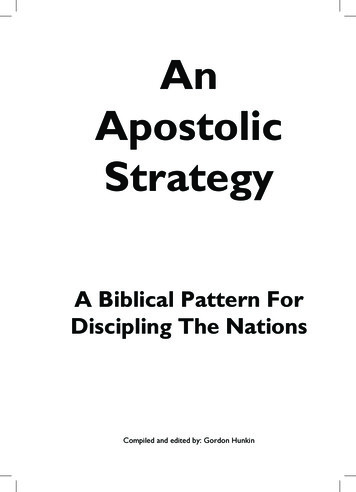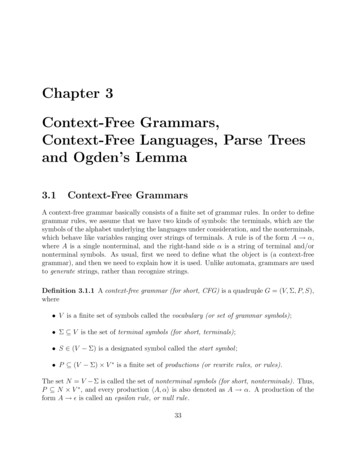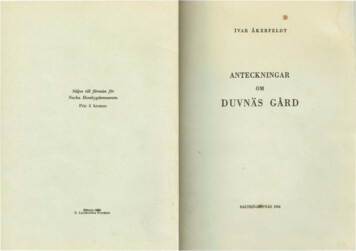
Transcription
A Context For Change / 1AnApostolicStrategyA Biblical Pattern ForDiscipling The NationsCompiled and edited by: Gordon Hunkin
2 / A Context For ChangeAn Apostolic StrategyA Biblical Pattern For Discipling The NationsCopyright 2006 New Covenant Ministries InternationalISBN: 0-620-371-79-XUnless otherwise indicated, all Scripture quotations are taken from theHOLY BIBLE, NEW INTERNATIONAL VERSION. Copyright 1973,1978,1984 by International Bible Society. Used by permission ofZondervan Publishing House.All rights reserved. The reproduction of any portion of thispublication in any form without prior permission of the publisheris prohibited. However, permission is hereby granted to reproduceportions from this publication for use in preaching and training,provided those portions are used in the context in which they arepresented in this publication, and full acknowledgement is madeof this publication.Published by Every Tribe Resources (www.everytribe.net) for NewCovenant Ministries International (www.ncmi.net).P. O. Box 67209, Bryanston, 2021, South Africa.Email: etr@ncmi.netOther Books in This Series Choosing Your Battles – 1999 A Servant’s Heart And Skilful Hands – 2000 Building On Apostolic Foundations – 2001 Building An Apostolic Culture – The Restoration of David’sTabernacle – 2003 Biblical Leadership – An Apostolic/Prophetic Model – 2004 Mentoring/Fathering – 2004
A Context For Change / 3AcknowledgementsThanks to all who have given of their timeand energy to help publish this book. Yourwillingness to help is not taken for grantedand is much appreciated.A special thanks to Malcolm Black and JennyPng for helping edit the manuscript, and toDonna McKellar for the cover design
4 / A Context For ChangeThis book is based on the module offered through theInternational Theological Correspondence College called“An Introduction To Apostolic Christianity.” More detail onthis module can be obtained from the ITCC website: www.itcconline.netBesides the material that was written specifically for theITCC course manual, the source material for this course(and this book) has come, by and large, from previouslypublished material. This includes material that was publishedin some of Dudley Daniel’s books as part of the EquippingFor Apostolic Christianity Series, namely, A Servant’s HeartAnd Skilful Hands, Building On Apostolic Foundations, andBuilding An Apostolic Culture. Other publications written byDudley Daniel that were used include: the series of trainingmanuals written by Dudley on Leading The Church, anin-house trans-local team training manual called, How ToConduct Yourself In The House Of God, and an article on BaseChurches published in the Let’s Talk Magazine #42. Let’s Talkis a New Covenant Ministries International publication.Extracts were also taken from the book, Now We Really Live,written by Ian McKellar, and Authentic Apostolicity, a bookletwritten by Chris Wienand. Finally, material was also usedfrom an article written by Rob Rufus entitled: The MinistryOf An Apostle.The shorter articles and booklets used will be offered asfree downloads on the Every Tribe Resources website –www.everytribe.net. Dudley’s and Ian’s books and manuals,except for the in-house manual, are available for purchase onthe website.
A Context For Change / 5Equipping For Apostolic ChristianityAt the heart of Apostolic Christianity is a passion tobe a Church that is determined to fulfil the commissiongiven by Jesus to "make disciples of all nations." We dothis by planting New Testament churches, training andreleasing large-capacity leaders, and bringing the wholepriesthood to a place of liberty and effectiveness.Apostolic Christianity finds its expression through aChurch that embraces the prophetic purposes of God inevery age, a Church that has the ability to see the futureas God sees it and prepares to become the future.Apostolic Christianity has a God-inspired zeal togo and not to gather, to send and not to stay. This is apeople who will give everything, without compromise, tobe what God calls them to be and to do what God callsthem to do.
6 / A Context For ChangeTable Of ContentsForewordTyrone DanielPage9Section OneIntroducing The Apostolic/Prophetic PatternChapter 1Chapter 2Chapter 3Chapter 4A Context For ChangeComponents Of The ChurchThe Cry Of A Sending GodLaying e47556473Section TwoThe New Testament ChurchChapter 5Chapter 6Chapter 7Chapter 8Mandate And MissionThe Model Of The ChurchApostolic StrategyBuilding TeamsSection ThreeThe Apostolic And Prophetic Ministries At WorkChapter 9Chapter 10Chapter 11Chapter 12Chapter 13The Apostolic Ministry – Part 1The Apostolic Ministry – Part 2An Apostolic BlueprintProphetic Promises, Presence AndPurposeBeing PropheticPagePagePage89103117PagePage134145
A Context For Change / 7AppendicesAppendix 1Appendix 2Appendix 3A Prophetic Word – DudleyDanielCharacteristics Of A HealthyChurch – Dudley DanielThe Church UniversalPage159PagePage161186
8 / A Context For Change
A Context For Change / 9FOREWORDThese are incredible days to be alive and we are privilegedjust to be a part of this great journey!!However, the Church today is facing many challenges –the wants and needs and the demands and distractionsthat wish to control the church, it’s future and ultimatelyit’s destiny!! There is no question that we, the Church,are busy, but wisdom says that we need to be sure we arebusy with the right things!“Apostolic Strategy” has been compiled with the futurein mind!There is nothing haphazard about God’s plan to reachthe world! The Bible is clear, the pattern is clear and themessage needs to be clear. What we read in the scripturesneeds to be what we see in the Church!Our hope is that this book will help all of us to take stockand give our attention to what is really important to God.Let us “keep the main thing the main thing” as we preparetoday, the Church for tomorrow! It has been said, “theBible has no suggestions, only commands” - may we then,not read it ‘suggestively’!Be blessed in your journey!Tyrone Daniel
10 / A Context For Change
A Context For Change / 11Section OneIntroducing TheApostolic/PropheticPattern
12 / A Context For Change
A Context For Change / 13Chapter 1A Context For ChangeThe authority of the Bible is a non-negotiable element ofapostolic Christianity. It is the full and final authority for the wholeof our lives, both personally and corporately. This must be true forevery issue we discuss. If we find something in the Word of Godthat does not fit with what we have thought or believed in the past,we have to lay aside our preconceptions, our pride and prejudiceand take a stand: no matter who thinks what, we will do things theBiblical way.We are living in a time that some have referred to as one inwhich we will see the ‘restoration of all things’. By implication,every one of us has to change, preacher and hearer alike. The Wordof God should direct that change. We believe that one of the keypassages that should guide us is the one in Acts 15, which tells usthat God is restoring the fallen tabernacle of David. Some havetaken this to mean a restoration in the area of praise and worship,but the restoration that God has ordained for His Church is muchmore comprehensive than that.We believe there is a Davidic wineskin that God is restoring tothe Church. David had a heart to do things God’s way. He diligentlyapplied the Word of God in both his private and his public life.Even when he failed God, he turned back to God and did not holdon to his pride or his own way. It is significant that it was underDavid’s rule that Israel won its greatest victories and captured themost territory. This will be characteristic of the Church as we seekto embrace the restoration that God brings to us. The applicationof a Davidic wineskin, we believe, will include the Church being
14 / A Context For Changebuilt, without compromise, according to the Word of God andaccording to the ways of God.As we said earlier, this implies that we will all need to embracechange in order to align ourselves and the Church with God’s Word.If that Word threatens our present modus operandi, preferences ortheologies, then let change come. Our attitude and response needsto be grounded in the kind of understanding we get from Acts 17:30:“In times of ignorance God overlooked things but now He commandsall people everywhere to repent.” While this relates specifically toour initial repentance in response to the Gospel, we believe that italso has an implication that requires us to be constantly repentingof wrong understanding, or modus operandi, in response to therevelation of God.What we will be focusing on in this publication is the revelationof God’s pattern for His Church. He has always had a pattern forHis people to follow in building His house. In Exodus 25:8 Godcommanded that a sanctuary be built for Him to dwell in and thatit be built exactly according to the specific pattern that He gave tothem then. Even under the old covenant He gave incredible detailin the revelation of that pattern.In 1 Chronicles 15:13 we read again that there was a definitepattern, a prescribed way that God had for the ark to be carried.They made the mistake of not finding out what this was and “Godbroke out against them.” Later on though, when they had found outwhat the prescribed way was and moved the ark the way God hadordained, it was great blessing that broke out.Time and time again in the Old Testament God gave detailedplans and patterns for His house and for the way He wanted thingsdone. Read Exodus 25-27, 1 Chronicles 29, 2 Chronicles 2:1-16and Ezekiel 43-45 and it is clear how important this is to God.If He had such a definite pattern for the tabernacle of the OldTestament, then surely He has no less than that for the Church inour day. He has always had prescribed ways.We know that the tabernacle itself pointed to Christ as Hispresence could never be contained in a physical structure made by
A Context For Change / 15human hands, but there was also a different ‘tabernacle’ that wasto come in which He would dwell. In the Church He has revealedthis dwelling place – a living, organic tabernacle, built with livingstones. If this is the expression of His dwelling place in this agethat was foreshadowed in the Old Testament, then surely He hasas much of a prescribed way for this tabernacle as He had for theprevious ones. We believe that this pattern is to be found in thewhole Bible and that details of how to work this out are revealed inthe New Testament.These are accessible to us as we have God’s Word. He wantsus to know, especially as leaders, that we can hear from Him andunderstand the intricate detail of how He wants us to build. He hasa blueprint. We believe it is based on Old Testament revelation, butit is found in much more detail and clarity in the New Testament– particularly in Acts. We find there the way that we should bebuilding the Church, both locally and trans-locally.Much of the challenge in working this out will lie in applyingGod’s Word as a Word that has absolute authority. This will becontested and there are also the dangers of applying His Word ina manner that He does not intend. There is a ‘Bible’ way to applythe Word.For example, there will be principles in the Word that we may bepassionate about and which the Holy Spirit has applied to our lives.We cannot, however, apply all of those principles to others in exactlythe same way that God has applied them in our lives. That couldbring bondage to them. It is therefore important to find the way ofGod in the application of truth. He knows best how to apply theseprinciples to each person’s life or to each local church. We do notmean to say that the truth does not apply to everyone, it does, butsome truths will be applied differently in different circumstancesand in different people’s lives.Consider this: there is only one instance where Jesus told anyonethat, in order to follow Him, he would have to sell all that he hadand give it to the poor. There is a principle here that applies toeveryone, which is that if we want the ‘pearl of great price’ we must
16 / A Context For Changebe willing to give all that we have in order to obtain it. The fact ofthe matter is, however, that Jesus did not tell any other person whofollowed Him to sell all their possessions. The application of thatsame principle is different for different people.When it comes to applying the Apostolic/Prophetic model thatwe are going to examine, there is a Biblical way to do this. Althoughit is rooted in the Word of God and thus rests on the authorityof that Word, we are not dealing with a model that is static; itis alive and dynamic. There is also a continual adjustment to ourunderstanding of that model as we are transformed in response tothe increasing revelation of God’s picture of the Church in HisWord. For that reason we have to constantly ask God Himself toshow us how to apply this model.This is a model that should always throb with the life of God andshould never be bogged down by rules and regulations that are ofour own making. It requires the life of God to thrive as it is a modelthat cannot be sustained by human passion alone. It is a model thatbrings and maintains a genuine liberty in the Church - a libertythat enables God’s people to live passionately for Him.It is thus vital that as we apply the functions of the apostolic andprophetic ministries we must bear in mind that these ministriesshould never have authority to lord it over any believer or any localchurch. Even though they do have a significant role in building theChurch, they are never to control it. The highest human authorityin a local church is always its own eldership or pastoral team, andthat must not be lost or undermined in any way.At the same time, as we will see, each church must be linked tothe bigger picture, the wider ramifications of the Gospel and thediscipling of the nations. This is where the role of the apostolic andprophetic ministries comes in. What we will discuss is how translocal, (Apostolic/Prophetic) teams are valid Biblical structures forfacilitating this linking of local churches into the bigger picture.There is, however, a particular way that the partnership between thelocal and the trans-local is to be worked out, a way that is based onrelationship, not on hierarchy or institutionalised structures.
A Context For Change / 17In the Scripture, particularly in Acts, we see that local churcheswere established with the help of trans-local, Apostolic/Propheticgifting so that, from the start, the right foundations were laid intothe church. Likewise today, trans-local ministries are administeredthrough teams of men and women working together to buildthe Church. Through relationship with trans-local teams, localchurches are linked to the whole of what God wants to do throughthe Church. Let us be clear about this at the outset, if this is sothen this relationship is not an ‘optional extra’ for local churches.It is the only legitimate (and thus the most effective) model for theChurch.It is always to be a model that brings a mutual and voluntaryaccountability to local churches and to trans-local teams. It is also amodel that releases the full potential of the ministries and gifts thatGod has given to the Church. It does so within a God-given contextthat is intended to prevent any person, local church or ministry tooperate independently or to build a platform other than one thatfacilitates the work of the Kingdom. Jesus is at the head, and notany person or ministry. All work together to serve Him and thebigger picture, without any part receiving a profile or position thatis solely for its own benefit.
18 / Components Of The ChurchChapter 2Components Of The ChurchLet us begin our examination of God’s pattern for the Churchwith what we believe are the three major components of theChurch:The wine The wineskin The worshippers/workers The imagery of the wine and wineskin is taken from Jesus’teaching in three of the Gospels (Matthew 9:4-17; Mark 2:18-22;Luke 5:33-39) and is applied to the Church as a flexible, livingcontainer for the wine. The worshippers, who are also the workers,are the people of God who, together, form the corporate expressionthat is, in the context of this image, the wineskin that exists to getthe wine to those who are thirsty.The wine speaks of His life, power, creativity and activity inthe Church. There can be no argument that all that God does isaccomplished through the work of the Holy Spirit in the Churchtoday. This interpretation of what the wine is strengthened by thepassage in Acts 2 where we read that those who had been baptisedwith the Holy Spirit were not drunk with wine but with the Spiritof God Who had come down. Another text that is applicable here isEphesians 5:18: “Do not get drunk on wine, which leads to debauchery.Instead, be filled with the Spirit.”The wine is the Holy Spirit and the manifestations of Hispresence and activity are evidence of that wine, but more accurately
Components Of The Church / 19it is Jesus, by His Spirit, coming to the Church. We would like tosay then that the wine is Jesus coming, dwelling and working byHis Spirit. Through the wineskin (the Church) that same wine isbrought to the lips and the lives of those who are thirsty. So whilewe believe that it is correct to say that wine is a type of the HolySpirit, we believe that the wine is to be more fully understood asbeing Jesus – by His Spirit.When we are saved it is Jesus who comes into our lives by HisSpirit. Paul writes to the Romans in chapter 8:8-9“So then, those who are in the flesh cannot please God.But you are not in the flesh but in the Spirit, if indeedthe Spirit of God dwells in you. Now if anyone does nothave the Spirit of Christ, he is not His.”It is Jesus that we want to see come to those who are thirsty. Heis the focus of every manifestation of the Holy Spirit. While themanifestations of the Spirit are often the most tangible aspect ofthe wine for us, we must remember that, as powerful and as vital asthose manifestations are, Jesus is the focus.Having said that, it is important to note that as this wine ispoured into the wineskin and finds its expression in and throughour lives, there will be both intangible and tangible evidence of this.There will thus be manifestations of the Holy Spirit when the wineis present. The manifestations of the Holy Spirit through the agesare multifaceted and varied and it would be absolutely impossibleto record every one of them. He is the Holy Spirit, who is theCreator. He was active in Genesis 1:1 and 2: “In the beginning Godcreated the heavens and the earth,” and, “The Spirit of God hovered,over the face of the deep.”While we understand that God the Father, in His role withinthe Trinity, spoke the word of creation, the Holy Spirit was activein that process. The Holy Spirit was active in the creation of everydaisy, every lily, every different colour, leaf, shape, and bird.
20 / Components Of The ChurchWhat I am trying to say is that the work and manifestation ofthe Holy Spirit is so diverse and so big that we would never beable to record everything that the Holy Spirit can possibly do inone book, not even in the Bible. We will thus find that there aremanifestations of the Spirit that are not specifically recorded in theBible. What we do find though, is that among all those that arerecorded, some of these manifestations are emphasised in the Bibleand others are not. A good guideline in applying the Word of Godis thus to emphasise those manifestations of the Holy Spirit (Jesuscoming to His Church) that the Bible does. This is one way inwhich we can keep the focus on Jesus.There are other things that the Holy Spirit does that are notemphasised or recorded that we can enjoy, but when we emphasisewhat the Bible does not emphasise, we get into trouble. When wemake something the focus that the Holy Spirit, who authored theBible, does not, we get out of step with Him. In the same vein, wehave to be careful when we say that something that is happening inthe Church cannot possibly be God at all. There are many things thatare possible within God’s creativity and which are manifestations ofthe Spirit, but they are simply not to be an emphasis.The wine is His presence with us in person. While we canexperience the person, He is not merely an experience. It is importantthat we remember that the Holy Spirit is a person and not an ‘it’.He is a person who acts in ways that impact and transform lives.The wonderful reality of the person of the Holy Spirit is a precioustruth that has been restored to the Church in our time and there isstill more that we will see made manifest.We believe that God’s plan for us is a fuller expression of theHoly Spirit. The fullness of the ‘new wine’ includes the cultureof the Kingdom breaking into the present, either for a sustainedmanifestation, or for a brief period – which is what a miracle is.When the fullness of the Spirit is made manifest, signs and wonders,healings, joy, deliverance of body, soul and spirit are all a part of the‘natural’ lifestyle of the Kingdom.
Components Of The Church / 21We come now to the wineskin. We believe that the wineskinof the Church is the structure of the Church. In other words, it ishere where the Pattern that God has for His Church will need to beapplied. There are at least four aspects to the wineskin:Vision – is rooted in God’s vision for the Church universal andis given specific form by what God wants each local church tobe. It goes further than simply seeing people saved, and includesthe specific plan of God for each local church. Values – are about how we fulfil God’s vision without cuttingacross Scripture or violating our conscience. Authority structure – is the actual structure of Churchgovernment, paying special attention to who is released intoleadership and how they exercise it. The kind of leaders releasedwill determine the effectiveness of each church within the contextof God’s work, and for how long the work will be effective. Biblical working model – must be based on Scripture andmust be producing fruit. The wine is God Himself and there is never any fault with Him.The wineskin is the corporate structure (made up of believersin fellowship with each other) that God intends to contain anddispense the wine, but Jesus made it clear that there can be faultwith the wineskin. We can build a corporate structure that is notbuilt according to God’s pattern.As we consider the Apostolic/Prophetic model of the Churchthen, the challenge will be to learn to ensure that we, as a wineskin,are Biblical, flexible and are expanding or enlarging. As He restoresa Davidic wineskin to the Church God not only wants to changethe shape of the wineskin, but He also wants to change the sizeof it. God in heaven has an abundance of wine to pour into theChurch and there is still so much of the Holy Spirit that needs tobreak in on us. For that to happen, God requires a wineskin thatcan, at the very least, cope with more than we have seen so far.
22 / Components Of The ChurchMost of us have already experienced some wonderful things, butthere has to be more than that. It has to be larger than that, moresustained than that. This is the desire of God’s heart, to take us intothe ‘more’. That is why He is intent on transforming the wineskin.Always remember though that the wineskin is not an end initself. The sole purpose of the wineskin is to get the wine to thepeople. When you are thirsty and someone has water, you do notwant them to hold up the container and begin to expound on itsbenefits and qualities. You would not be interested in the containerat that moment; you want the ‘stuff’ that is inside, the water. In spiteof that, we see people travelling the world to look at the wineskins.Many even try to ‘import’ the wineskin into their own context,often without even having the wine.The wineskin is crucial to what God is doing in the world today.God has a plan, a very specific agenda, for this world. The highpointof this plan was the coming of Christ and the final fulfilment ofGod’s plan will be seen when Jesus comes again. In between is theage in which we live, and in that age the most important issue forthe Church is what God wants to do in the world through HisChurch.Prior to Jesus, God worked out His plan for humankind throughHis chosen people, the nation of Israel. Since Jesus came, died androse again, God has focused His activity in the world through theChurch. Israel still has a role to play in God’s plan but He has onlyone Holy Nation, which is now made up of both Jew and Gentile.The Church was created to be the primary vehicle for God’s workin the earth.It has, however, often been the case that the wineskin, orstructure, of the Church has not been able to sustain the flow of thenew wine, or life in the Spirit, to the thirsty. Throughout Churchhistory there have been various moves of holiness and the fear ofGod, but none of them have been sustained. The same is true forvarious moves of power and healing.
Components Of The Church / 23There are many that pray for revival, for a restoration of reverencefor God in the Church. Some focus on holiness and holy living andothers wait only for signs and wonders. Many Christians believethat today is the ‘harvest time’. Others will emphasise the truththat God is restoring the apostles and prophets back to the Church.These and other moves of God are all part of His agenda, but manyhave failed to find a sustained expression in the Church.This is not only true of moves that took place in the last sevenor eight centuries, but it is also true of some of the most powerfulmoves of God that took place at the inception of the Church. Thisis the case in modern day Turkey, which includes ancient Asia andGalatia, where there are almost no believers left today. What hashappened to the Church?We believe that the reason for this is that the pattern of God forthe Church was lost and, as a result, it was unable to sustain theways, the work or the moves of God. Revivals, holiness and giftsof the Spirit are all important and vital to the development of theChurch, but they cannot be sustained unless there is a wineskinthat can properly contain and administer them. This being the case,God’s highest priority is to prepare a wineskin that can containand sustain everything that He wants to restore to the Church, awineskin that is suitable for the administration of the Kingdomof God. The wineskin is the Church’s strategic structure.God is building a wineskin that is true to His Word and Heis building it to last for eternity. Therefore, the duty of believersin the Church is to give ourselves to the building of a Church inaccordance with God’s Word and His ways.Everything in a local church – the structure, programmes, andeven the leadership – should be fashioned in such a manner thatthey facilitate the administration and sustaining of the flow of thenew wine that God is pouring out. We need to remember that thethings of the Spirit are organic and will not suffer being limited byorganisational models. What we need is God’s model. We cannotsimply apply any model that we see working in the world. The
24 / Components Of The Churchconstant challenge for the Church is to be adjusting everything thatis done to facilitate the in-flow and outworking of the new wine.This adjustment must be made in response to what we see in God’sWord.There are many things that constitute a wineskin that is suitablefor the Kingdom of God. We will examine some of these as weinvestigate the Apostolic/Prophetic model that God has given forbuilding His Church.The wineskin is the corporate expression of the Church, whichis made up of individual believers. These are worshippers who dothe work of the Kingdom. The work of the worshippers shouldalways be motivated by a wholehearted, loving worship for God.The Biblical perspective of work and worship is that they areinterlinked activities of the people of God.As the wine and wineskin come together in an accurate Biblicalpattern the result will be an expression of true worship. UltimatelyGod is not even looking for wine, let alone the wineskin, as vitallyimportant as these are to fulfil His plan. He is seeking worshippers,people who are touched by the presence of God. Before churchmembers are anything else, they must be worshippers. There is novalue in us having a perfect wineskin if we are not worshippers.All service for God is to be worship. We do not do the workof the Kingdom with a heart of fear or because of any pressure.It is a sheer delight. Nothing stops us working for God, becauseit is a thrill to do so. If, however, we are only workers withoutbeing worshippers, we will eventually run out of steam. If we areworshippers first (such as God seeks) we simply do not run out ofresources.
The Cry Of A Sending God / 25Chapter 3The Cry Of A Sending God“How, then, can they call on the One they have not believedin? And how can they believe in the One of Whom theyhave not heard? And how can they hear without someonepreaching to them? And how can they preach unless theyare sent? As it is written, ‘How beautiful are the feet ofthose who bring good news!’”Romans 10:14Having discussed a Biblical context for change and outlinedwhat we believe are the three essential elements of the Church, weare ready to lay a more detailed theological foundation for what wecall the Apostolic/Prophetic model of the Church.From the beginning the Gospel (good news) has been a ‘going/sending’ – apostolic – message. It has always been in God’s heart tobless all nations. We see this in the life of Abraham. He was calledto go and be a blessing to all nations, which would have an impactfor all future generations.The Abrahamic covenant of Genesis 12:1-4 is called the “gospelin advance” in Galatians 3:6-9.“The Lord had said to Abram, ‘Leave your country, yourpeople and
Dudley Daniel that were used include: the series of training manuals written by Dudley on Leading The Church, an in-house trans-local team training manual called, How To Conduct Yourself In The House Of God, and an article on Base Chur











